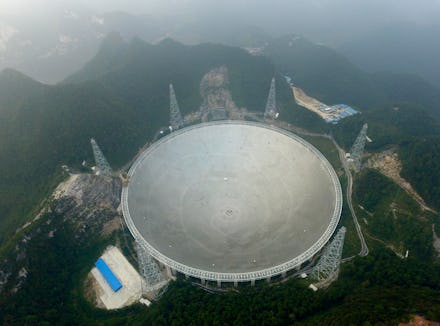The largest radio telescope ever built will reveal parts of the universe we've never seen

Is anybody out there? We might find out soon.
The world's largest radio telescope is now up and running in China, and it's already searching for undiscovered stars and galaxies and listening for signs of alien life.
The 500-meter Aperture Spherical Telescope, or FAST, took about five years and $180 million to complete, according to the Associated Press. About 8,000 people were displaced from their homes in the southern Guizhou province of China to create the required 3-mile radius of radio silence around the telescope.
Seeing what no telescope has seen before
FAST's enormous size gives it an advantage over other telescopes, according to Chinese Academy of Sciences researcher Chengmin Zhang.
"The bigger the collecting area of radio waves from space, the more sensitivity it holds, implying it can detect the most dim radio signals in the universe that scientists have not yet observed," Zhang said in an email. "Namely, FAST has the ability to see into the deep universe, where unexpected things may exist."
It will take about three years to get the telescopes calibrated, but once it's tuned up, it could give us a look at some of the very first stars that formed in the universe, the BBC reported.
Listening for aliens
FAST's size will also increase our chances of finding alien life out in the cosmos.
"FAST's potential to discover an alien civilization will be five to 10 times that of current equipment, as it can see farther and darker planets," Peng Bo, director of the NAO Radio Astronomy Technology Laboratory, told the Chinese news agency Xinhua.
FAST won't be able to directly detect "little green men," Zhang said, but it could pick up signs of alien life.
"In the next two decades, we may find more new planets, or water and life [in deep space], or even a second earth," Zhang said.
This telescope is another example of China ramping up its investment in space science. Earlier this month, the Chinese space agency launched its second space station, Tiangong-2. The launch happened just before the space agency announced it had lost control of Tiangong-1. Now the 8.5-ton space station will crash back down to Earth in 2017.